The geothermal sector is tuned into the same trends that, to a large extent, are driving the HVACR industry as a whole.
At the recent AHR Expo, representatives of geothermal companies most often listed decarbonization and electrification, the transition to A2L refrigerants, and the consumer incentives available for higher-efficiency systems when the talk turned to current industry trends. Consumer education and ease of product serviceability were mentioned as well.
Here’s what geothermal experts at five companies had to say about market trends when The ACHR NEWS visited their booths at McCormick Place in Chicago.
director of marketing and communications
WaterFurnace International
Decarbonization and Electrification
Geothermal products, which harness heating and cooling energy from relatively stable underground temperatures, regardless of the weather above, are a natural fit for increasing energy efficiency and furthering the decarbonization movement.
“We’re positioned very, very well to take advantage of electrification and decarbonization,” said Tim Litton, director of marketing and communications at WaterFurnace International. “A lot of areas are realizing the only way to meet their energy goals are to use something like geothermal … because of the fact that it doesn’t matter if it’s hot outside or cold outside. It’s because it lowers the (energy) infrastructure needs so greatly.”
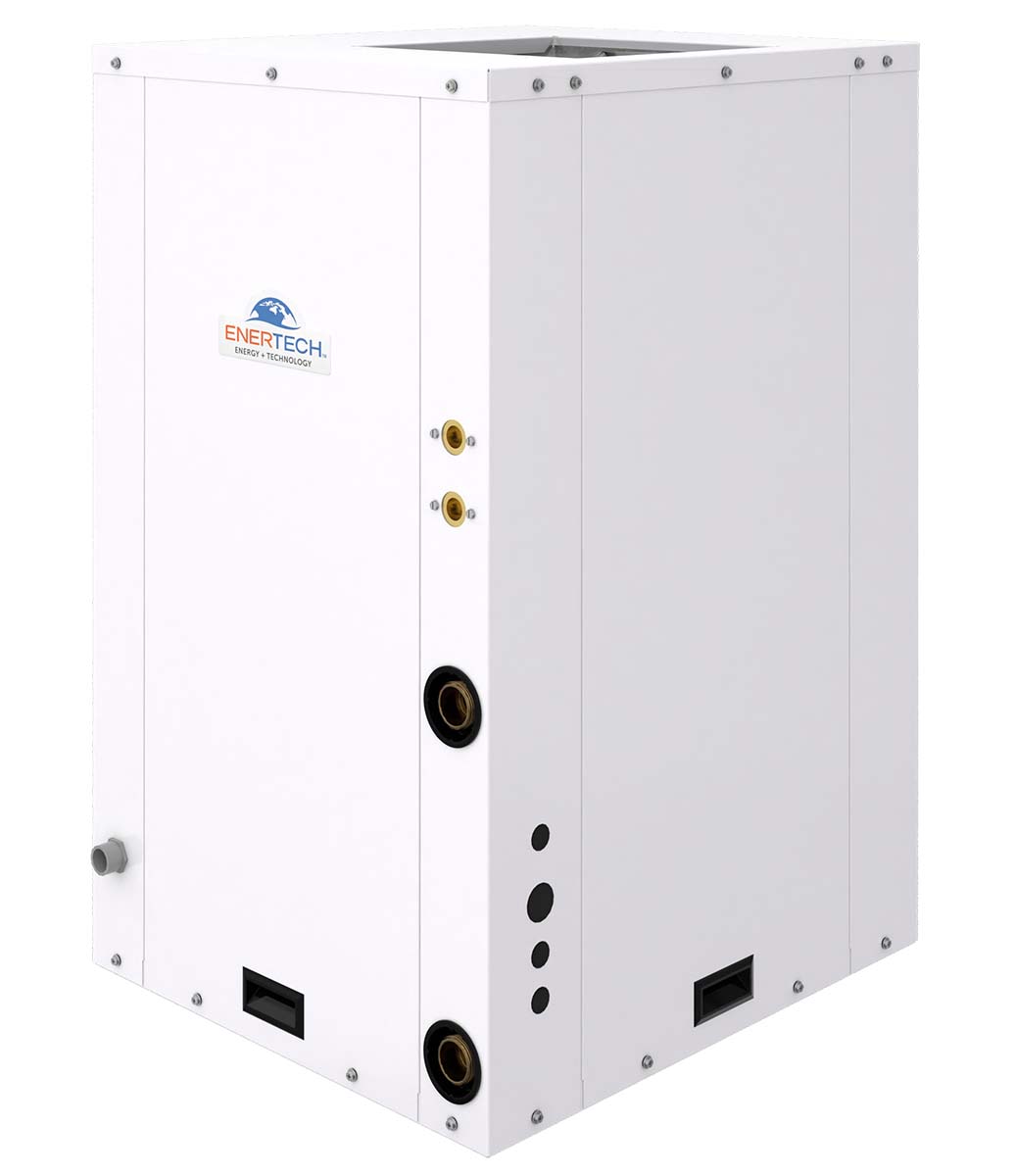
COMPACT UNITS: An Enertech Compact Vertical Packaged (VS/VT) heat pump. The capacities of the units range from a half-ton to 6 tons; they have variable-speed fans (optional on the VS), an option for a single- or a two-stage compressor, and domestic hot water assist. (Courtesy of Enertech Global)
“Everything is pushing electrification,” said Jeffrey Lawrence, director of commercial accounts at Enertech Global, which makes geothermal heat pumps. “‘Heat pump’ is just the buzzword across the planet.”
The trend is fueling growing interest in geothermal products, both on the commercial side and the residential side.
“We have units from South Florida to Alaska and everywhere in between,” said Litton. “We have a fairly high market share in Canada.”
“We’re seeing a great deal of increase now on the commercial side of the business,” said Joe Parsons, senior marketing and sustainability manager at ClimateMaster. “Because, finally, there’s an understanding of the amount of dollars (incentives) that are out there that ... offset the cost of installation.”
Education and Incentives
ClimateMaster, Parsons said, is putting a lot of effort into publicizing the incentives, such as the 179D federal tax deductions for commercial projects, available for geothermal systems. The company has given presentations, participated in webinars, and published a downloadable “geoeconomics calculator” to spread the word.
The calculator, Parsons said, compares the cost of a geothermal system for a specific project, with tax incentives applied, to the cost of a more traditional HVAC system for the same project.
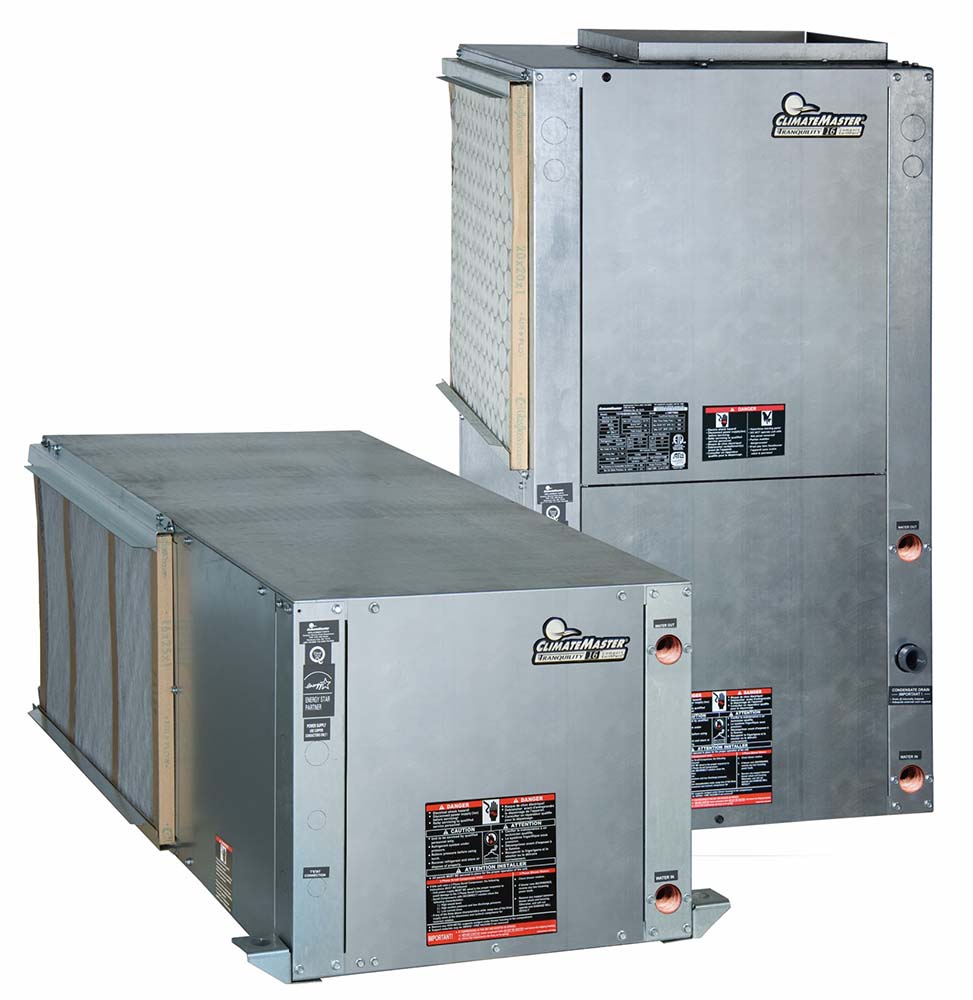
LEED LEADER: A Tranquility 18 (SR) Versatile Series water-source heat pump from ClimateMaster. The units use R-454B refrigerant, are eligible for Leadership in Energy and Environmental Design points, and exceed ASHRAE 90.1 efficiency standards. (Courtesy of ClimateMaster Inc.)
“We found convincing evidence to say that system that normally would pay for itself (through energy savings) in seven, eight years could be cash-positive in the first year with federal tax credits,” he said.
Lawrence said that, from Enertech’s point of view, incentives and creative financing are increasing the popularity of geothermal systems in Northeastern states. “Clearly, that’s what’s pushing a lot of it,” he said.
“The Northeast is the biggest geothermal market in the country. New York state ... has gone gangbusters with this technology,” Lawrence said, “It’s just the political climate in the Northeast. And they have some very good new signups to rebates.”
There are also financing programs that, for example, will provide a bridge loan to help pay for a geothermal system while the consumer waits for a rebate, he said.
Geothermal companies also have to educate consumers on the energy savings that come with geothermal systems, as those systems are not as well understood as traditional, fossil fuel-burning, and electric HVAC.
“It’s all about education,” said Jeremy Moore, geothermal product marketing manager at Carrier Corp. “Once someone really understands geothermal, the benefits are just right there, plain and simple. But it’s really about consumer education.”
Refrigerant Transition
R-454B appears to be the refrigerant of choice for geothermal manufacturers as they work to comply with the federal regulations that will phase out the use of hydrofluorocarbon (HFC) refrigerants such as R-410A.
The phaseout is already well underway, with production and import of HFC refrigerants already cut by 40% from the established baseline. Equipment is next; by January, all newly manufactured residential HVAC equipment must use refrigerants with a global warming potential of less than 700.
Geothermal companies say they’ll be ready.
“We should have R-454B products certainly being available in about the second quarter of this year,” said Michael Stevens, geothermal and water-source heat pump national sales manager at Bosch Home Comfort USA.
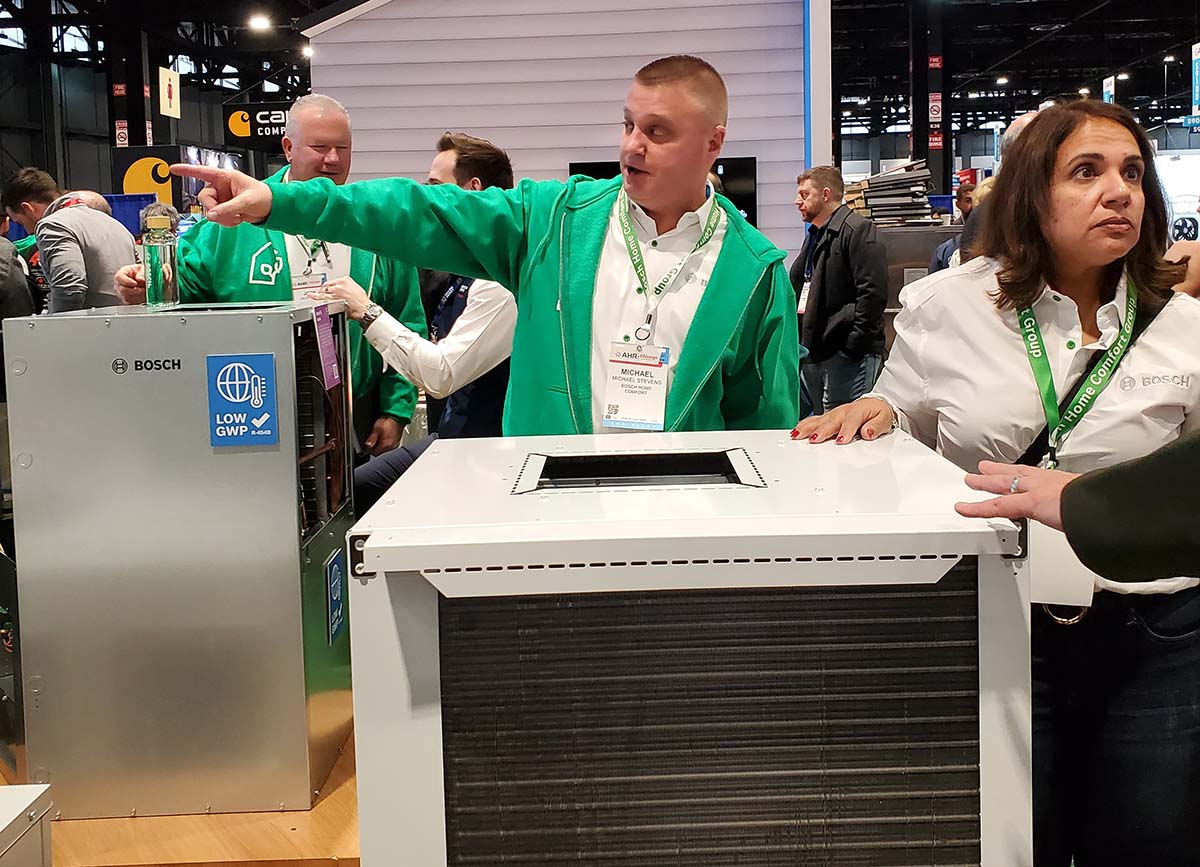
BOOTH TOURS: Michael Stevens, geothermal and water-source heat pump national sales manager, and Sarah Dunlop, a regional sales manager, field questions at the Bosch Home Comfort booth on the first day of the AHR Expo. Dunlop is standing next to a Bosch RF Series geothermal heat pump, while a RL Series model is at left. (Staff photo)
“We have already brand-tested some R-454B,” said Lawrence, at Enertech. “And we’ll be ready when that exactly is required of us.”
ClimateMaster is also moving its products to R-454B, Parsons said.
WaterFurnace has two products that use R-454B refrigerant, the WaterFurnace 5 Series 3D and the GeoStar-brand Aston 3D ground-source heat pumps, that the company expects will be available to order in the second quarter of the year. WaterFurnace is a direct-to-contractor brand, while GeoStar equipment is sold through distributors.
“We’re a little bit ahead of the curve there in transitioning over to the new refrigerant,” Litton said. WaterFurnace plans to introduce all of its R-454B products by the end of the year.
At Carrier, Moore said, the company is using the refrigerant transition as an opportunity to revisit its geothermal technology in an attempt to gain efficiencies.
“We’re not only looking at it from just changing over the refrigerant,” he said. “We’re looking at it from an innovative perspective of, ‘How can we squeeze every ounce of efficiency out of these pieces of equipment?’”
Carrier is shifting equipment from Puron, the company’s brand of R-410A, to Puron Advance, an R-454B refrigerant, and will have compliant products on the market by the end of the year, Moore said.
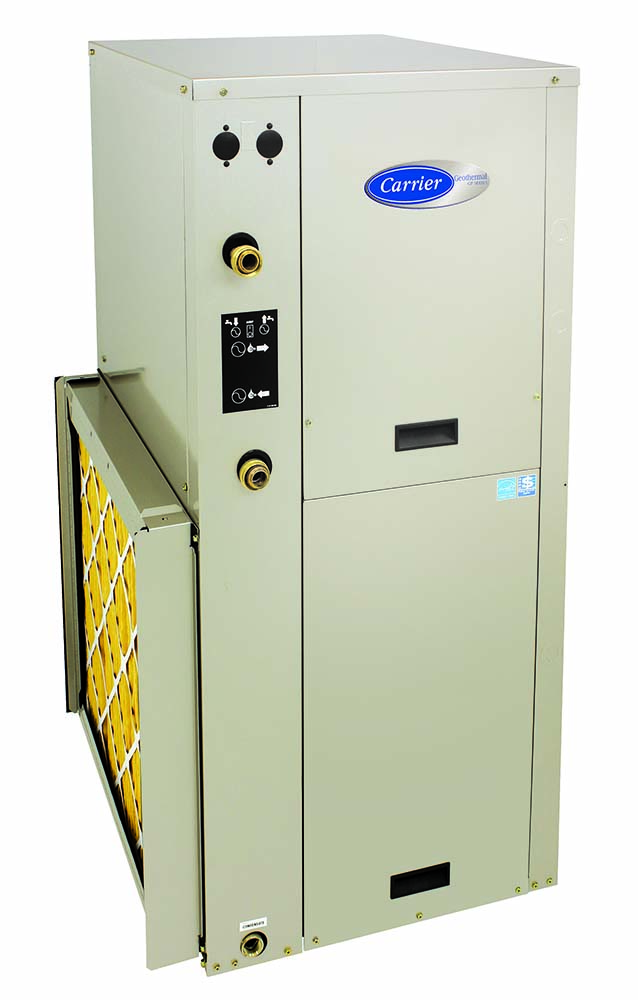
CARRIER GEOTHERMAL: A Carrier Performance model water-source geothermal heat pump. The Performance line features variable-speed blower motors and two-stage compressors and can be outfitted to provide domestic hot water. (Courtesy of Carrier Corp.)
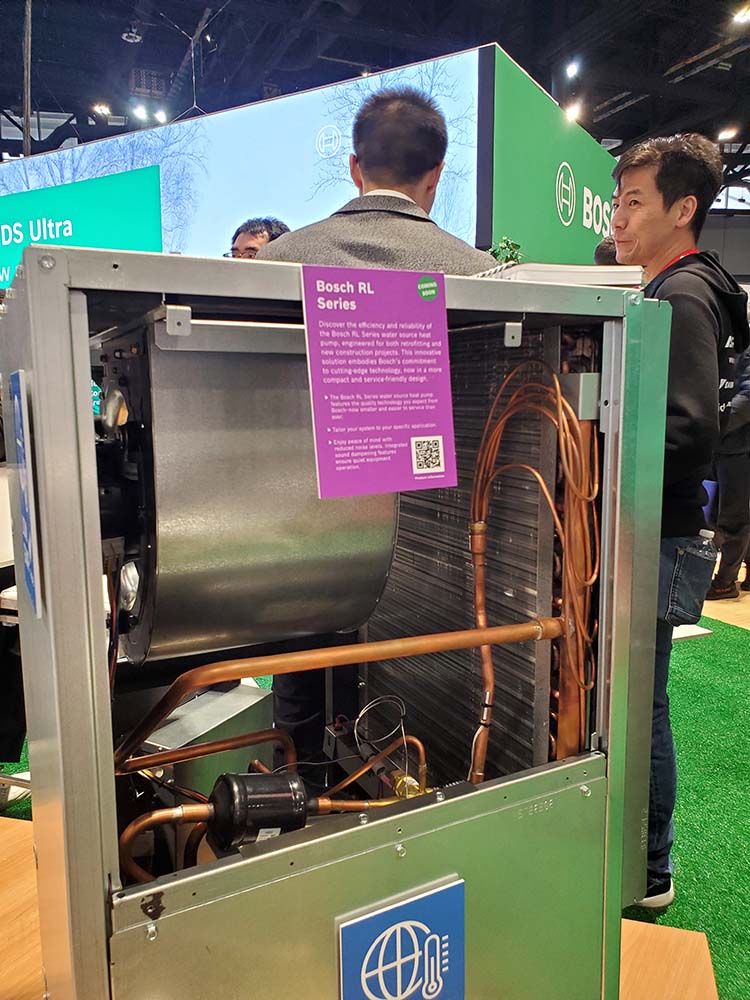
REDESIGN: The interior of a Bosch RL Series water-source geothermal heat pump. The RL models, to be released later this year, will feature a removable control panel, improved coil serviceability from the front of the unit, and a slide-out blower. (Staff photo)
Ease of Service
Bosch, Stevens said, is focused on a trend toward increasing the serviceability of HVAC equipment.
Its RL Series water-source heat pumps feature a swinging, removable control panel for easy access, improved coil serviceability from the front of the unit, and a slide-out blower. The RL heat pumps, which should hit the market later this year, will also feature smaller footprints, factory-installed filter driers, and insulated refrigerant lines, Stevens said.
“We’re just really excited about the new product offering coming out of Bosch,” Stevens said. “Basically, we like the feedback that we’re getting out there in the public on the serviceability side of it. ... They’ll see some positive, exciting things in the future coming from Bosch for water-source heat pumps and geothermal applications.”



Report Abusive Comment